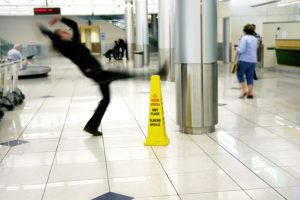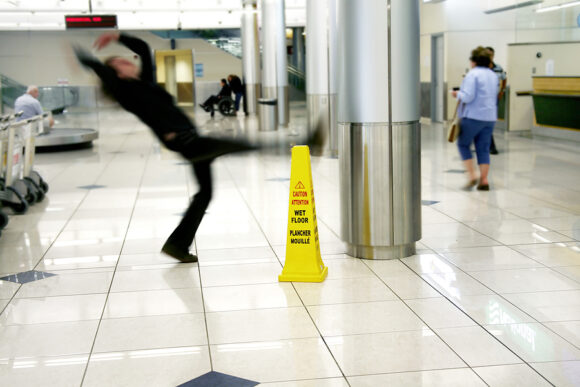The results released in a Slip and Fall Study Report by CNA, an insurance and risk management services provider for businesses and professionals worldwide, reveal that tested floors in 50 percent of the surveyed sites failed to produce a dynamic coefficient of friction (DCOF) level above the minimum threshold of 0.42 (American National Standards Institute). Ultimately, these findings suggest that many businesses’ fall prevention programs may overlook the effects of flooring selection and ongoing maintenance on slip resistance.
“Slip and falls can happen anywhere, any time and to anyone, and addressing the slip resistance and maintenance of interior floors to reduce exposures is critical to enhancing floor safety,” said Steve Hernandez, senior vice president, Risk Control, CNA Commercial. “The CNA data uncovered that slip and fall claims overtime occur with more frequency than severity, and continue to pose challenges for businesses. These findings underscore the need for attention to floor safety and regular surface resistance testing to avoid fall accidents and related injuries.”
CNA’s review of slip and fall liability claims occurring from Jan. 1, 2010, to Dec. 31, 2016, found high-frequency but low-severity trends, which is consistent with claim experiences in the greater risk control industry. According to frequency data, retail trade and real estate businesses present the greatest potential for slip and fall accidents, with harmful events occurring most often at these sites:
- 40 percent on walking/working surfaces, mainly entry flooring.
- 33 percent on parking lot surfaces.
- 27 percent on sidewalks leading to business entrances.
- Less than one percent on interior office floors.
Despite low-severity trends, traumatic brain injuries (TBI) can result from severe slip and fall injuries. Using predictive analytics and data mining, CNA found that the rate and seriousness of TBI claims were higher for general liability insureds than workers’ compensation insureds.
In an effort to help businesses apply safety measures, CNA identifies four principles of floor safety:
- Choose flooring that is slip resistant; consider its properties and the space and environment.
- Test floor for their resistance under wet conditions; use a tribometer to measure DCOF levels.
- Use cleaning agents and methods that are compatible with the floor type, and apply them as directed by the manufacturers.
- Promote awareness of risk conditions in the physical environment, along with those that are specific to the flooring.
“Given the focus on floor safety, it’s important for businesses to revisit prevention efforts, in order to guarantee that floors and walkways are safe through the application of safety standards,” said Shari Falkenburg, assistant vice president, Risk Control, CNA Commercial. “By conducting routine slip resistance testing, businesses can be better prepared to comply with flooring manufacturers’ specifications, and on how to address the level of contaminants on walkway surfaces.”
Download the Slip and Fall Study Report at go.cna.com/slipandfall.
Was this article valuable?
Here are more articles you may enjoy.


 Musk’s X Probed by UK Over Grok’s Thousands of Sexualized Images
Musk’s X Probed by UK Over Grok’s Thousands of Sexualized Images  Munich Re: Insured Losses From Wildfires, Storms and Floods Hit Record High
Munich Re: Insured Losses From Wildfires, Storms and Floods Hit Record High  Cyber Breach Affected 750,000 Canadian Investors, Regulator Says
Cyber Breach Affected 750,000 Canadian Investors, Regulator Says  Billionaire NFL Owner Suing Over Billboards Near His SoFi Stadium
Billionaire NFL Owner Suing Over Billboards Near His SoFi Stadium 